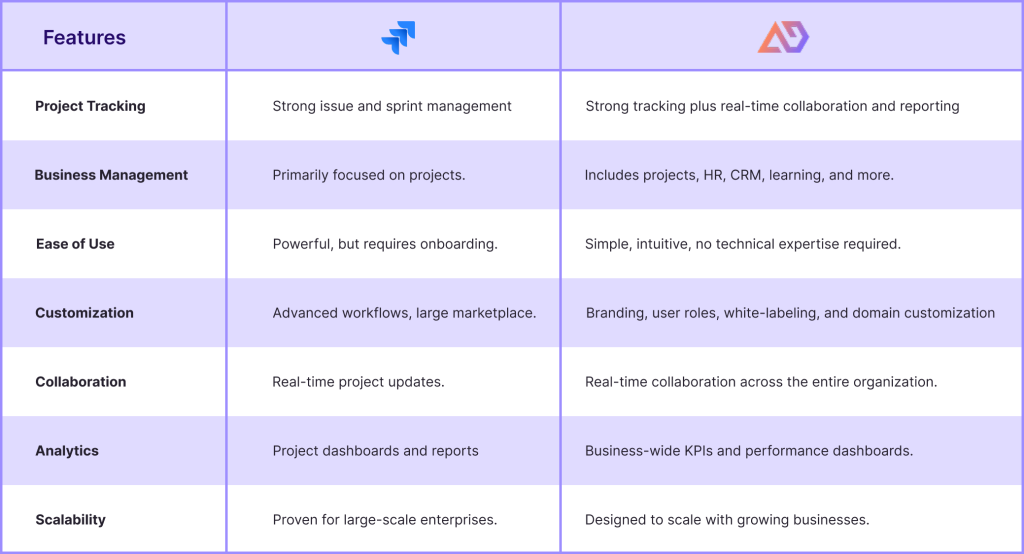AmDital vs Jira: The Complete Comparison for Modern Businesses

In the age of digital transformation, businesses are under constant pressure to deliver faster, collaborate better, and maintain efficiency across every department. The right management software can make or break this balance. Among the most popular names in this space are Jira, a well-established leader in project tracking, and AmDital, an emerging all-in-one business management platform designed to streamline not just projects but the entire business ecosystem.
At first glance, both platforms seem similar they help teams stay organized and productive. But a closer look reveals a fundamental difference: Jira specializes in project and issue tracking, whereas AmDital extends far beyond projects to unify multiple business functions in one platform.
Let’s explore both platforms in detail to understand how they compare.
Jira: The Specialist in Project Management
Jira, created by Atlassian, has become synonymous with agile project tracking. It is widely used by software development, IT, and DevOps teams to manage backlogs, bugs, and sprints.
Some of its notable strengths include:
- Agile boards: Kanban and Scrum boards for visual task management.
- Custom workflows: Highly flexible setups to match team processes.
- Integrations: Seamless connection with Atlassian tools like Confluence, Bitbucket, and Trello.
- Scalability: Trusted by enterprises worldwide for large and complex projects.
For technical teams with complex workflows, Jira is a proven, reliable system. Its detailed issue tracking and workflow customization make it an excellent tool when the primary focus is project execution at scale.
AmDital: The All-in-One Business Growth Partner
AmDital takes a different approach. Instead of being just another project management tool, it positions itself as a comprehensive business management platform. It includes all the core features of project management but expands into areas that most businesses otherwise need separate tools for.
With AmDital, you can:
- Plan and manage projects with task assignment, collaboration, and progress monitoring.
- Track sales and manage clients using its built-in CRM.
- Oversee HR processes from employee management to performance evaluation.
- Enable learning and knowledge sharing through wikis, documentation, and training modules.
- Monitor company performance with interactive dashboards and KPI tracking.
What makes AmDital stand out is its focus on simplicity. Teams don’t need to be technical experts to get started, and managers can quickly set up dashboards and workflows without heavy customization. This makes it a natural fit for startups, agencies, and growing businesses that want more value from a single platform.
Understanding Jira
Jira, developed by Atlassian, is a market leader in project and issue tracking. It is especially popular with software development, IT, and agile-driven organizations. Its key capabilities include:
- Agile boards: Helps teams manage sprints, track progress, and organize backlogs.
- Issue tracking: Detailed tracking of bugs, tasks, and enhancements.
- Workflow customization: Build custom workflows that match specific project needs.
- Integration ecosystem: Works well with Atlassian tools (like Confluence, Bitbucket) and many third-party apps.
- Enterprise scalability: Supports large, complex teams and global organizations.
Jira shines in structured environments where project visibility and task-level detail are critical.
Understanding AmDital
AmDital is more than just a project management tool it is designed to be a complete business operating system. While it offers project and task tracking features, its strength lies in centralizing different business functions, reducing the need for multiple tools.
Core strengths of AmDital include:
- Project Management: Real-time tracking, task assignment, and team collaboration.
- CRM & Sales Management: Built-in client and sales tracking to manage leads, opportunities, and pipelines.
- HR & Employee Management: Integrated HR functions like attendance, leave, and performance evaluation.
- Learning & Knowledge Sharing: Wikis, training modules, and documentation features to upskill teams.
- Performance Dashboards: Monitor KPIs across departments for data-driven decision-making.
- Customization & Branding: White-label options, personalized domains, and role-based access.
With AmDital, businesses gain a single ecosystem that covers projects, people, processes, and performance ultimately saving time, reducing costs, and enabling growth.
Key Feature Comparison
Here’s a quick side-by-side look at how the two platforms align:

Why Businesses Lean Toward AmDital
The biggest reason businesses choose AmDital is its all-in-one nature. Instead of paying for and managing multiple tools one for projects, another for HR, another for sales, and yet another for knowledge sharing AmDital puts everything under a single roof.
This approach creates several advantages:
- Unified workflows: Teams don’t waste time switching between apps.
- Cost savings: One subscription covers multiple business functions.
- Faster adoption: Employees find it easier to learn and use.
- Growth-ready: As the company scales, AmDital scales with it without adding tool complexity.
It’s not just about managing projects. It’s about creating a connected ecosystem where projects, people, and performance all work together.
Key Takeaway
Both Jira and AmDital are powerful tools that bring immense value to organizations. Jira continues to be an excellent choice for teams that need robust project tracking, especially in technical and agile environments.
However, for businesses that want to simplify operations, reduce tool overload, and bring multiple business functions into a single platform, AmDital shines as the more comprehensive choice.
By combining project management with sales, HR, learning, and analytics, AmDital transforms from just a tool into a complete growth partner making it the smarter option for modern businesses looking to scale efficiently.



 Sep 25,2025
Sep 25,2025  By akshada gulave
By akshada gulave 


